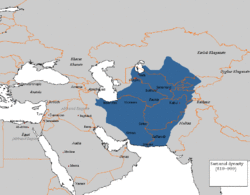Samanid Empire
Appearance
(Reguidit frae Samanid dynasty)
The "Scots" that wis uised in this airticle wis written bi a body that haesna a guid grip on the leid. Please mak this airticle mair better gin ye can. (December 2020) |
Samani سامانیان | |||||||||||||||||
|---|---|---|---|---|---|---|---|---|---|---|---|---|---|---|---|---|---|
| 819–999 | |||||||||||||||||
 The Samanid Empire at its greatest extent under Isma'il ibn Ahmad | |||||||||||||||||
| Caipital | Balkh, Bukhara | ||||||||||||||||
| Common leids | Persian (releegious decree/mither tongue),[1][2] Arabic (art/science)[3] | ||||||||||||||||
| Releegion | Sunni Islam | ||||||||||||||||
| Govrenment | Emirate | ||||||||||||||||
| Emir | |||||||||||||||||
• 819–855 | Yahya ibn Asad | ||||||||||||||||
• 999 | 'Abd al-Malik II | ||||||||||||||||
| Historical era | Medieval | ||||||||||||||||
• Established | 819 | ||||||||||||||||
• Disestablished | 999 | ||||||||||||||||
| Aurie | |||||||||||||||||
| 928 est. | 2,850,000 km2 (1,100,000 sq mi) | ||||||||||||||||
| |||||||||||||||||
| The day pairt o | |||||||||||||||||
The Samani dynasty (Persie: سامانیان, Tajik: Сомониён - Sāmāniyān), forby kent as the Samanid Empire, or simply Samanids (819–999),[4] was a Sunni[5] Persian Empire[6][7] in Central Asia, named efter its founder Saman Khuda, wha convert tae Islam[8] despite bein frae Zoroastrian theocratic nobility. It wis a native Persie dynasty in Greater Iran an Central Asie efter the foonderin o the Sassanid Persie empire caused bi the Arab conquest.
References
[eedit | eedit soorce]- ↑ "Persian Prose Literature." World Eras. 2002. HighBeam Research. (September 3, 2012);"Princes, although they were often tutored in Arabic and religious subjects, frequently did not feel as comfortable with the Arabic language and preferred literature in Persian, which was either their mother tongue—as in the case of dynasties such as the Saffarids (861–1003), Samanids (873–1005), and Buyids (945–1055)...". [1]
- ↑ Elton L. Daniel, History of Iran, (Greenwood Press, 2001), 74.
- ↑ The Samanids, The David Collection. Islamic dynasties
- ↑ Encyclopædia Britannica, Online Edition, 2007, Samani Dynasty, LINK
- ↑ Rene Grousset, The Empire of the Steppes:A History of Central Asia, transl. Naomi Walford, (Rutgers University Press, 2002), 143.
- ↑ The Encyclopaedia of Islam (article by Clifford Edmund Bosworth) writes: SAMANIDS, a Persian dynasty which ruled in Transoxania and then in Khurasan also, at first as subordinate governors of the Tahirids [q. v. ] and then later autonomous, virtually independent rulers (204-395/819-1005)
- ↑
- A historical atlas of Uzbekistan, By Aisha Khan, Published by The Rosen Publishing Group, 2003, ISBN 0-8239-3868-9, ISBN 978-0-8239-3868-1, pg. 23;
- The Cambridge History of Iran, By Richard Nelson Frye, William Bayne Fisher, John Andrew Boyle, Published by Cambridge University Press, 1975, ISBN 0-521-20093-8, ISBN 978-0-521-20093-6, pg. 164;
- The New Encyclopædia Britannica, By Encyclopædia Britannica Publishers, Inc. Staff, Encyclopædia Britannica, inc, Published by Encyclopædia Britannica, 1987, ISBN 0-85229-443-3, ISBN 978-0-85229-443-7, pg. 891;
- The monumental inscriptions from early Islamic Iran and Transoxiana, By Sheila Blair, Published by BRILL, 1992, ISBN 90-04-09367-2, ISBN 978-90-04-09367-6, pg. 27.
- ↑ The History of Iran By Elton L. Daniel, pg. 74
| This Asie-relatit airticle is a stub. Ye can help Wikipaedia bi expandin it. |
Categeries:
- Pages uisin collapsible list wi both background an text-align in titlestyle
- States an territories established in 819
- 875 establishments
- 999 disestablishments
- History o Iran
- History o Tajikistan
- Dynasties o Afghanistan
- History o Kazakhstan
- History o Kyrgyzstan
- History o Pakistan
- History o Uzbekistan
- History o Turkmenistan
- Muslim dynasties
- History o Islam
- Samanids
- Iranian dynasties
- Asie stubs
